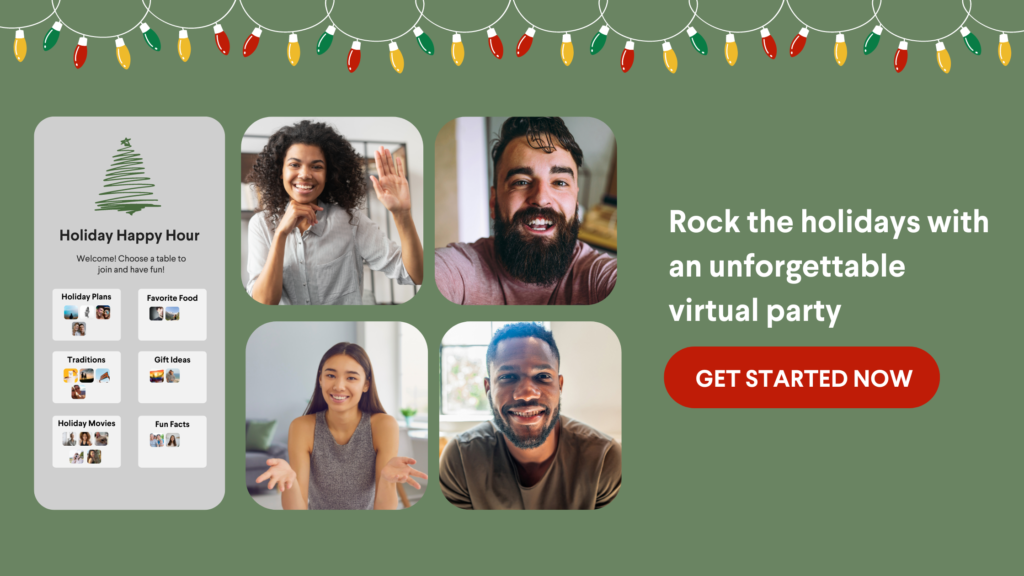What will company holiday parties look like in the post-COVID era?
Despite an initial revival of in-person events this year, many companies still won’t host in-person holiday celebrations in an effort to protect the health of their teams. Instead, more brands will host virtual holiday parties this year, in which the usual festivities like a gift exchange, holiday games, and company messages are coordinated through an online event platform—and we expect to see some incredibly inventive celebrations.
To help you adapt your company holiday party for an online environment, let’s explore how to host a virtual holiday party that your team will actually want to join.
How to Plan a Virtual Workplace Holiday Party in Seven Steps
We recommend you start planning your virtual holiday party at least three weeks out from your potential party date. If you have less time than that, though, don’t worry—these seven steps will fast-track your ability to plan an engaging online holiday party for your team.
Step 1: Designate a Lead
Just like any other event planning process for your team, you should designate one person to oversee the holiday party planning process. In most cases, this will be a member of your human resources or executive support teams.
This event planning lead will help manage deadlines, pull in team support as needed, and partner with various departments to gain the necessary approvals and resources (like a budget).
If you are designated the lead for your holiday party planning—don’t worry, it’s easier than you might think, and you don’t have to do everything yourself. This leads us to our next step…
Step 2: Form a Holiday Party Planning Committee
Depending on the size of your company, the holiday planning lead should create a committee with at least one or two other team members. Again, these team members will most likely be from human resources or administrative support teams, because they typically have experience with workplace event planning.
However, encourage any member of your team to join the committee if they would like to. The holiday season may be the favorite time of year for some of your colleagues, and they can infuse a natural excitement and sense of delight into your planning.
Step 3: Survey Your Team’s Holiday Party Wishes
Do you want to know the not-so-secret way to ensure you host a great workplace holiday party? Use feedback from your team members to guide your planning.
The worst way to throw a holiday party is to force everyone to attend at an assigned day and time that they had no influence in choosing, especially if it is after normal business hours.
Create a quick survey for your team through Google Forms or your preferred surveying tool. At a minimum, cover these essential areas:
- Would you like to attend a company holiday party? Or would you prefer time off, a holiday bonus, or a charitable gift in your name instead?
- What are your ideal days of the week and times for a holiday party?
- What days or times can you not attend a holiday party?
- Are you interested in a voluntary company-wide gift exchange or similar activity?
- What would you like to do at the virtual holiday party? Select your top 3 preferences:
- Open conversation with colleagues in a large group setting
- Open conversation with colleagues in small-groups
- Structured, longer group activities
- Short, high-energy activities that take just a few minutes each
- Gift exchange
- Hands-on cooking or crafting class
- Other (please explain):
- Is there anything else we should know to make this event great for you?
In addition to your survey results, have 1:1 conversations with team members to further explore their hopes for the holiday party. All of this information will help you understand how many team members will attend, gather ideas for the best virtual holiday party activities to host, and the technical requirements to accomplish them.
Step 4: Pick a Virtual Holiday Party Platform
The technology you choose to host your virtual holiday party can easily make or break the experience. Keep your attendee wishes top-of-mind as you explore options, and find a solution that enables your attendees to meaningfully connect and mingle.
You will ask many questions similar to what you’d ask when picking an ideal virtual conference platform, including:
- What type of customization is available?
- How many attendees can this platform support?
- Does the price scale with attendance?
- Are there custom breakout rooms for attendees to network? Is there a limit to the number of these rooms?
- Are there built-in networking components?
Step 5 (Optional): Designate a Theme
If desired, you can now pick a theme for your holiday party to influence the activities you host (we’ll dive into that next), what your team will wear, and how you design your invitations.
A theme is a “nice-to-have” element that is completely optional. If this is your first year hosting a virtual holiday party, it may be best to skip the theme and focus solely on meeting the needs of your attendees (unless a theme is a must-have for them).
If you’re looking for inspiration on what theme to pick for a holiday workplace party, this article has a handful of themes and activities you can explore.
Step 6: Build an Agenda of Activities
This is where the real fun happens! Now that you have everyone’s feedback in-hand, and know what functionality is available to you, your holiday party planning committee can determine your holiday party’s activities.
Save the first 10 minutes of your holiday party for everyone to log-in and get familiarized with the platform. Then, kick off your celebration with a brief welcome from a member of your company leadership or your holiday party planning committee.
Depending on how long your party is and what your team has expressed in your pre-event conversations, you should offer a combination of open networking rooms and structured activities to appeal to the range of your team’s needs.
To help you, we’ve created a list of 10 workplace virtual holiday party games that work great online, with details on how to approach each of them.
Step 7: Invite team members
You’re almost there! The last step to planning a holiday party is to get the word out to your team.
Ideally, you should send emails to each employee to personally invite them to the holiday party. Include the date, time, and log-in instructions, as well as any details about the series of events and how they should prepare. Send a calendar invitation to all team members once the email invitations are sent.
Ask everyone to RSVP as soon as they know whether or not they can attend. Follow up with anyone you have not heard back two days after sending your initial email and invitations.

Throw Your Best Holiday Party Ever on Frameable Events
By using feedback from your teammates to build your virtual holiday party experience, you are more likely to host an event that your team will genuinely love.
If this is your first time hosting a virtual holiday party, do not stress about making the experience perfect. Instead, focus on opportunities to celebrate your team and enable them to connect with one another in the capacity of their choosing.
We’ve built Frameable Events to support holiday parties for teams of any size, with fully customizable spaces that give your employees the flexibility and freedom they deserve at your party. Learn more about what makes Frameable Events the ideal platform for virtual workplace holiday parties and try it out for free today.










